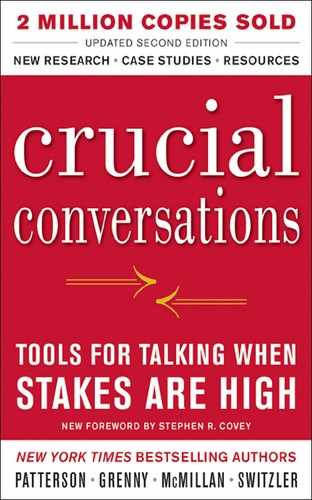STEP OUT. MAKE IT SAFE. THEN STEP BACK IN
Okay, let’s look at Yvonne. She tried to tackle a tough topic. Good for her. She was already uncomfortable and her partner took a cheap shot at her. Some help he was. Now what should she do? How can she get back to honest and healthy dialogue? What do you do when you don’t feel like it’s safe to share what’s on your mind?
The key is to step out of the content of the conversation. Don’t stay stuck in what’s being said. Yvonne exited because she was focused on what Jotham was saying. If she had been looking at Jotham’s conditions of dialogue, she would have spotted his use of sarcasm—a form of silence. Rather than talking openly about his concern and adding to the Pool of Shared Meaning, he’s taking a potshot. Why would he do that? Because he doesn’t feel safe using dialogue.
Unfortunately, Yvonne then missed this point. Now, we’re not suggesting that Jotham’s behavior is acceptable, or that Yvonne should put up with it. But first things first—Start with Heart. The first question is: “What do I really want?”
If you really want to have a healthy conversation about a topic that will make or break your relationship, then for a moment or two you may have to set aside confronting the current issue—i.e., Jotham’s sarcasm.
At this moment, Yvonne needs to build safety—enough to talk about their physical relationship, about the way Jotham is dealing with it, or about any other concerns. But if she doesn’t make it safe, all she’s going to experience is an unhealthy continuation of the silence and violence games.
So, what should she do?
In these circumstances, the worst at dialogue do what both Jotham and Yvonne did. Like Jotham, they totally ignore the crying need for more safety. They say whatever is on their minds— with no regard for how it will be received. Or like Yvonne, they conclude the topic is completely unsafe and move to silence.
The good realize that safety is at risk, but they fix it in exactly the wrong way. They try to make the subject more palatable by sugarcoating their message. “Oh, honey, I really want to be with you but I’m under a lot of pressure at work, and the stress makes it hard for me to enjoy our time together.” They try to make things safer by watering down or dressing up their content. This strategy, of course, avoids the real problem, and it never gets fixed.
The best don’t play games. Period. They know that in order to solve their problem, they’ll need to talk about their problem—with no pretending, sugarcoating, or faking. So they do something completely different. They step out of the content of the conversation, make it safe, and then step back in. Once safety is restored, they can talk about nearly anything.
For example, Yvonne gets back on the path of dialogue by saying: “Can we change gears for a minute? I’d like to talk about what happens when we’re not romantically in sync. It would be good if we could both share what’s working and what isn’t. My goal isn’t to make you feel guilty, and I certainly don’t want to become defensive. What I’d really love is for us to come up with a solution that makes us both satisfied in our relationship.”
